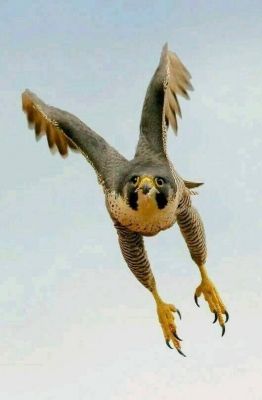
Coloration is a bluish gray above, with black bars on the white to yellowish white underparts. Adult peregrines range from about 36 to 49 cm (14.2 to 19.3 inches) in length. Strong and fast, they hunt by flying high and then diving at their prey. Attaining tremendous speeds of more than 320 km (200 miles) per hour, they strike with clenched talons and kill by impact. Their prey includes ducks and a wide variety of songbirds and shorebirds. Peregrines inhabit rocky open country near water where birds are plentiful. The usual nest is a mere scrape on a ledge high on a cliff, but a few populations use city skyscrapers or tree nests built by other bird species. The clutch is three or four reddish brown eggs, and incubation lasts about a month. The young fledge in five to six weeks.
Captive peregrine falcons have long been used in the sport of falconry. After World War II the peregrine falcon suffered a precipitous population decline throughout most of its global range. In most regions, including North America, the chief cause of the decline was traced to the pesticide DDT, which the birds had obtained from their avian prey. The chemical had become concentrated in the peregrine’s tissues and interfered with the deposition of calcium in the eggshells, causing them to be abnormally thin and prone to breakage. In the British Isles, direct mortality from another pesticide, dieldrin, was the most important cause of the decline. Following the banning or great reduction in the use of most organochlorine pesticides, populations have rebounded in virtually every part of the world and now exceed historical levels in many regions.
Credit : Britannica
Picture Credit : Google




